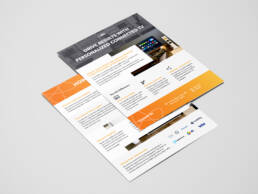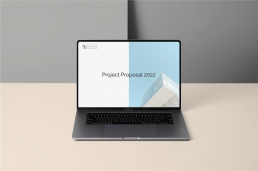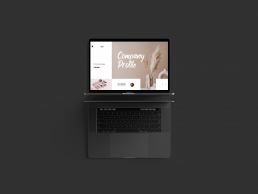Business presentations are used in every stage of the customer journey. As buying culture trends towards shorter sales lifecycles and reducing steps in the buying process, presentations remain a powerful business tool.
And as the saying goes “with great power comes great responsibility.” In this case, meaning since your continued success relies on the effectiveness of your presentations, it’s important to have the proper deck and design ready to support your teams.
This blog will take you through the nine presentations your company should have in your arsenal and how to make them more effective.
01. Investor Pitch Deck
This is the first presentation on the list because an investor pitch deck is one of the most critical presentations to have if you seek funding. Giving a presentation can be nerve-wracking on its own, but when money is on the table – the pressure intensifies. You don’t want to leave this one for chance. You wouldn’t skydive with a parachute sewn by a first-time seamstress, so don’t try to DIY your deck if you’ve never designed a successful one before. I always recommend investing in a professionally designed investor pitch deck (say that five times fast).
What’s inside an investor pitch deck?
An investor pitch deck is a short presentation prepared for potential investors. The goal is to inform people of your product or service, show them the value (aka, the return on investment, or ROI) and persuade them to invest in your future. Investors get pitched daily, so they don’t have a lot of time for a long presentation before seeing the ROI. Your deck should be short, clear, and get to the ROI in under four minutes.
Investor pitches should:
- Inform
- Show the ROI
- Persuade
Examples
See our examples of an effective Investor Pitch Deck here and here.

As a startup, if you must have only one deck, make it this one.
02. One Pager Sales Deck
Consider the one-pager sales deck (also known as a “one sheet”) the bait for your sales team. A one-pager sales deck is a one-slide PDF that summarizes the value of your product or service. It’s a high-level, easily digestible document that speaks directly to your ideal customer’s needs and is often used in the first touchpoint your team makes with potential clients.
Now, I know what you’re thinking. How can you possibly cram the details, the value, and your competitive advantage into a single slide? It’s possible! In fact, it’s a great training sheet for new sales team members to distill what’s truly relevant to clients and how to perfect their elevator pitch. It’s also an extremely effective tool in the age of tl;dr (too long; didn’t read).
How sales can use one pager sales decks
Like I said before, one pager sales decks are your sales team’s big juicy worm. One pager sales decks work great attached to an email to a prospective client or even sent via a LinkedIn direct message. Because it’s just one page, there’s very little commitment and more people are likely to “take the bait” to look it over. They’re a great tool for sales team members to use because they get the prospect aware of the solution you offer. Once the prospect expresses interest, your team can follow up with a short sales deck or calendar link.
One pager sales decks should:
- Be one page
- Make great first touchpoints
- Be concise

No one has time to read anymore. Capture attention easily with an initial one sheet.
03. Short Sales Deck
Once your prospective customer schedules a sales call, it’s time to break out your short sales deck. Also known as a sales pitch deck, these presentations are used to help salespeople persuade potential customers to buy your product/service. Like its name hints, these presentations are short, often less than five minutes.
An effective presentation uses a combination of brevity and social proof to move someone from the awareness to the consideration stage of the customer journey. It must briefly convey the problem you solve, how you solve it, and why your solution is the best solution. Your prospects are very busy managing their own companies, so do not include fluff in this presentation. I do, however, like to include relatable testimonials, and measurable success, and sometimes include links to deeper case studies and demos.
Short sales pitch decks should include:
- The problem you solve
- How you solve the problem
- Why your solution is the best
- Measurable client success statics
- Links to case studies and demos

A good idea is not enough if you can’t sell it. Let your sales deck speak for you.
04. Long Sales Pitch Deck
That’s right, you need two versions of your sales deck – a long version and a short version. Your long sales deck is where you can dive into more technical details about your product, the challenges faced, and your solution. This presentation can be reserved for potential clients that are more technical/knowledgeable but should continue to be brief.
After years of designing decks, I’ve found that the more technical a potential client is, the less fluff they’re willing to hear. Whether you’re designing a long or short presentation, it’s in your best interest to stay concise.
In addition to helping on the sales call, a long sales presentation has immense after-call value. I always recommend you A/B test sharing these decks as a follow-up touchpoint after your initial meeting. It’s the perfect way to continue persuading clients in industries with a longer sales cycle or to answer any silent objections.
Long sales pitch decks should include:
- Everything in the short sales deck, plus
- Technical details and specs
- Process details
- Deeper insight into how it solves a problem
- Screenshots
- Links to case studies and demos
Example
See an example of a highly effective long sales deck here.

Big price tag or more technical buyers? Keep a long (and detailed) version of your sales deck in your back pocket.
05. Demo Presentation
When presenting to technical users, nothing beats a live demonstration. Demos can be helpful when pitching products, services, and concepts. Their purpose is to educate people by going under the hood to show technical aspects of your product, show unique IP, or address deeper pain points you solve.
A great demo presentation design should be rich with product screenshots that highlight key features that set your product apart from the market.
Demo Videos vs Demo Presentations
There are strategic advantages to having a demo presentation as well as a demo video. Demo videos are great for on-demand viewing before your sales team is brought in or for self-service sales models. (Think of demo videos as marketing assets or to sell without salespeople.)
You’ve probably seen many demo videos on YouTube or in TV commercials. Nike, Adidas, and other sports retailers are famous for using demo videos in advertising to show layers of their products and designs that make them superior. Software companies like AirTable and Slack have hundreds of versions of highly persuasive demo videos that work for their self-service business model.
For industries where salespeople are still the stars of the show, demo presentations are key. There’s nothing more awkward than pausing a sales call to silently sit through a demo video. Demo presentations allow your sales team to run through a live demo, highlighting only the relevant features to that potential client. They can be used during sales calls to high-value potential clients or to show potential investors why your concept is viable.
Demo presentations are for:
- Investors
- Potential Technical Clients
- Product Concepts
- Sales Team
Examples
See an example of a brief demo deck here.

End users are not interested in missions, visions, strategies, or even ROI. It’s efficiency they are after–show it to them.
06. Brand Guidelines Deck
Every successful company has clear and effective brand guidelines at its foundation. The purpose of brand guidelines is to take the individual elements of your branding and visually guide employees on how to bring them together, consistently. As you grow, your branding will change many times and your messaging will adapt to be more convert to your ideal client. Each time you adapt your brand, your guidelines must be updated to keep everyone on the same page.
Not having an updated guidelines presentation is the equivalent of asking multiple chefs to create a dish with the same ingredients. Each will use the same ingredients slightly differently, resulting in dishes that are unlikely to look or taste the same.
Brand it like Batman
Still not convinced on the detriments of branding with no brand guidelines? Read my recent article on how beloved superhero, Batman, uses his branding to stand out. You want your branding to be consistent and recognizable, like Batman’s, no matter where it’s used, in the kitchen or the streets of Gotham. Consistent branding is what leads to greater brand awareness.
We can’t all be Batman, but we can all have consistent branding.
Brand guidelines should:
- Inform how individual elements come together to define your visual brand
- Include things like your logo, color, fonts, and font sizes
- Be updated regularly

As soon as you engage more than one designer, you should start thinking about your Brand Guidelines.
07. Conference Presentation Template
I’ll just come out and say it – most conference presentations are boring. Businesses pay a lot of money to send their “best” presenters to high-profile conferences in hopes of creating more brand awareness and leads. Some do this and do it well. For the rest of us, we need to rely on a great presentation to help guide us. (Myself included.)
Now, you could argue that strong presenters entertain their audience, but I believe the best presentations build a story around what you are trying to convey. Presentations that tell stories are more memorable, not just because of what’s on the slides but how the slides come together. We’ve all seen the slide decks that have the entire speech written on them or sat through presentations where each slide is an unconnected series of graphics that should go along with what the speaker is saying but are more distracting than supportive.
Don’t allow your company to be known for its hit or miss presentation. Invest in high-quality presentations that help even your most introverted employees become great presenters.
What makes great conference presentation templates?
Think back to when your elementary teacher taught you that all stories have a beginning, a middle, and an end. Now imagine having a template that guides you to create that beginning, middle, and end each time. One that guides you to create high-quality slides that balance text with visuals. Well-designed templates can do that. They can also help keep your branding consistent and recognizable from presenter to presenter.
Conference presentation templates should:
- Include your branding
- Guide your employees to develop strong presentations
- Build room to entertain and tell a story
- Be stored somewhere easily accessible to everyone

Conferences are unique–audiences are big, can be sitting far, and are typically tired after other sessions (and happy hours).
08. All-Hands Presentation
While meant for internal use only, never underestimate the power of a good all-hands presentation. All-hands presentations are used to communicate critical information, strategies, and updates throughout every level of your company. In fact, they’re likely to be your most used template.
It’s important to invest in a deck design built for consistency and quick edits because we both know internal presentations are infamously created last minute. I’ve even seen some being worked on just moments before the CEO actually opens it on a live call.
That same last-minute nature is exactly why all-hands presentations should be designed to make it easier for internal teams to work. I like to design them with lots of example images and icons to pull from. This allows the audience to focus on the message, not the design.
Something both the presentation creators and the audience appreciate.
All-Hands Decks Should Include:
- Example images
- Branded Icons
- Slides to communicate strategy
- Slides to communicate mergers and acquisitions
- Slides to announce
- Slides to inform
- Slides to open conversation
Examples
See an example of an internal financial presentation we did for Beyond Meat.

Less copy, more imagery, stats and data… Make sure you verbalize most of the information and use visuals as a support.
09. Case Studies
Always save the best for last. Out of all the presentations we’ve gone over, a good case study presentation is the most powerful tool in your sales arsenal. Case studies are more impactful than standard testimonials. They allow potential clients and investors to gain greater insight into your process for solving problems for similar brands. And whether or not you have case studies is practically a guaranteed question at the end of every pitch. This is why I believe a good case study can support your sales team’s efforts yet a great case study can sell all on its own.
Is one case study enough?
Yes, if you have only one product/service and only one ideal customer. Otherwise, I recommend you have a few case studies, one for each vertical, company size, and service you offer. Your presentation designer will know how to best create a template that touches on what each group is looking for when making buying decisions.
On top of increasing your persuasion abilities, a well-designed template creates a repeatable process that reduces the time spent creating each case. This comes in handy as you grow and start collecting case studies like playing cards. It’s also helpful because the easier it is to create a case study, the faster your team can publish and begin using it in sales pitches and on your website.
Have case study templates designed for each:
- Vertical you serve
- Company Size
- Type of project
- Service
- Product

Case Studies can be quick to design (*not* to write) and have a big impact on prospective clients.
In the end, the best presentation wins
Business presentations drive revenue. They simply do. Each of these nine presentations plays a key role in the customer journey. It’s up to you to invest in well-designed presentations that will help drive, not derail, each stage.
And you don’t even have to say it, I know you’re wondering if your marketing team has the design skills to create pretty versions of these presentations. I can practically hear you clicking the share button with your marketing director right now.
The answer is, they probably do. But pretty is only part of the equation. Pretty doesn’t equate to profit. If it did, you wouldn’t be researching this right now; you’d already have profitable versions of each of these presentations.
If you don’t yet, get in touch with me. My team and I specialize in presentation designs that infuse energy and excitement. Let’s discuss how we can equip your team with profitable versions of any of these nine presentations.

Borja Zamora
A Barcelona native but San Francisco based, Borja explores digital marketing and design through articles, images, and quotes.
Related Posts
December 12, 2024
10 Innovative Presentation Design Trends to Watch in 2025
Explore the top ten innovative presentation design trends for 2025 that will…
December 5, 2024
How to Become a Freelance Powerpoint Designer (Part 2)
Discover essential strategies for becoming a successful freelance PowerPoint…
December 5, 2024
How to Become a Freelance Powerpoint Designer (Part 1)
Unlock the secrets to becoming a successful freelance PowerPoint designer.…
September 18, 2024
Crafting Compelling Strategic Narratives: A Deeper Dive
Strategic narratives, the compelling tales that businesses weave to convey…
Related Posts
December 12, 2024
10 Innovative Presentation Design Trends to Watch in 2025
Explore the top ten innovative presentation design trends for 2025 that will…
December 5, 2024
How to Become a Freelance Powerpoint Designer (Part 2)
Discover essential strategies for becoming a successful freelance PowerPoint…
December 5, 2024
How to Become a Freelance Powerpoint Designer (Part 1)
Unlock the secrets to becoming a successful freelance PowerPoint designer.…
September 18, 2024
Crafting Compelling Strategic Narratives: A Deeper Dive
Strategic narratives, the compelling tales that businesses weave to convey…






